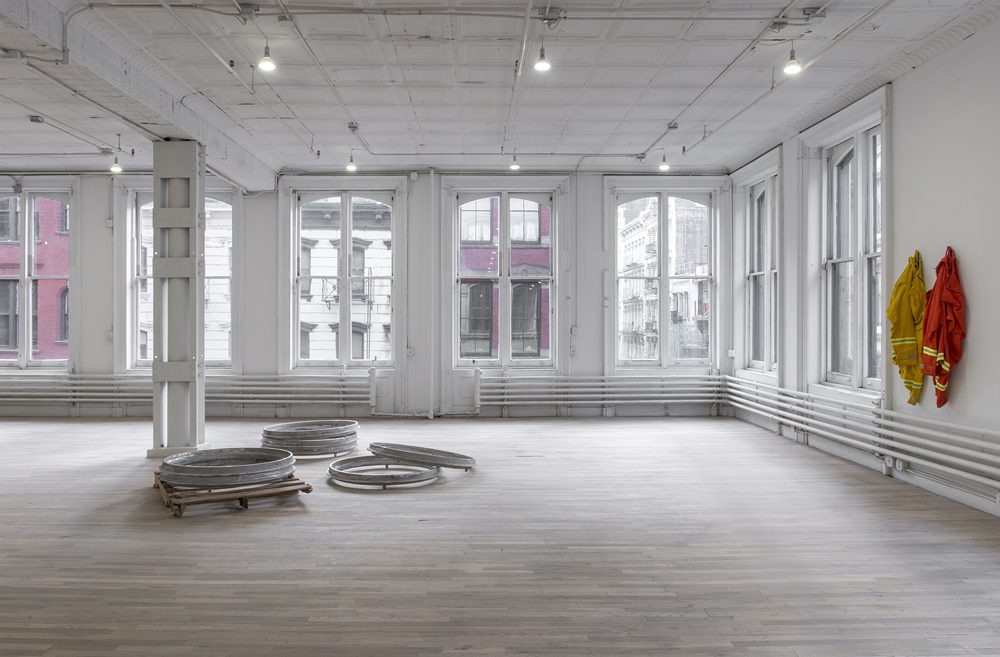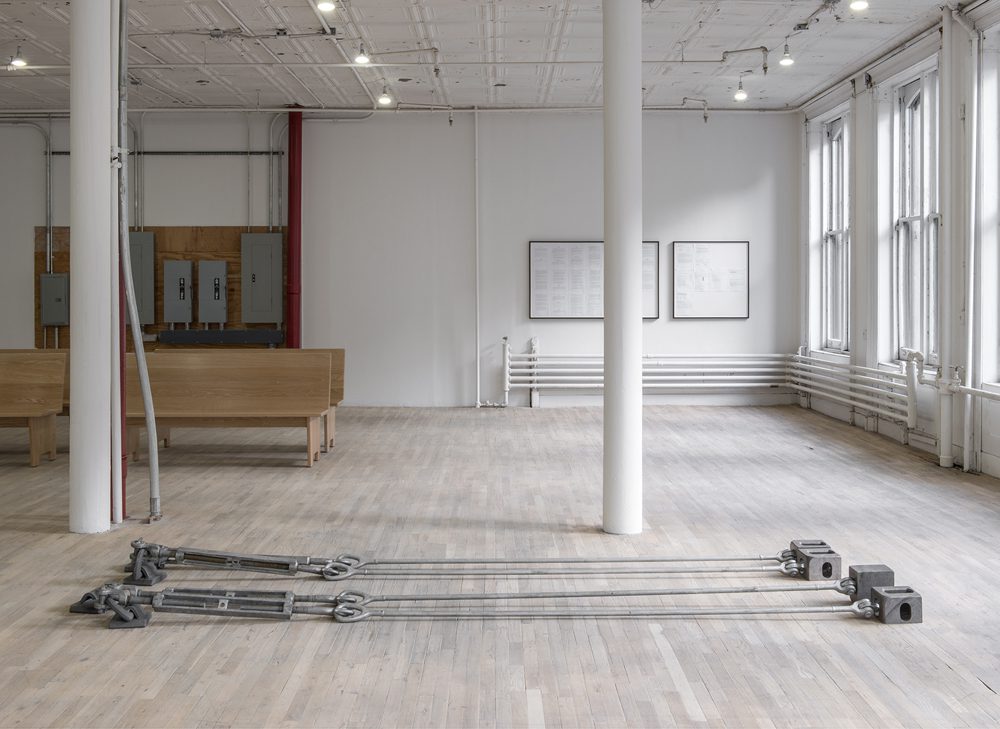Invisible Men: Cameron Rowland’s “91020000” at Artists Space
Ryan Lee Wong visits an exhibition in New York that sheds light on slavery’s legacy in our contemporary prison system.

Installation view from Cameron Rowland, “91020000,” Artists Space, New York, 2016. Photo by Adam Reich. Courtesy the artist and Artists Space, New York.
Editor's Note
At Pelican Bomb, our coverage centers around artists working in New Orleans and exhibitions presented in the region. But often artwork around the world can deepen the conversations we’re having here.
Louisiana has the highest incarceration rate in the United States, which has the highest incarceration rate of any nation in the world. Many local artists, including Keith Calhoun and Chandra McCormick, Jackie Sumell, and others—use their practices to investigate, unveil, and dismantle the prison industrial complex.
To add another artist’s approach to the discussion, we asked Ryan Lee Wong to visit Cameron Rowland’s “91020000” at Artists Space in New York.
Artist Cameron Rowland has entangled Artists Space in the prison labor system. Or rather, since all American people, institutions, and structures are already entangled in the machinery of mass incarceration, his exhibition renders visible some of those hidden webs.
The project consists of a scholarly paper on the history of prison labor, printed documents relating to the formation of a trust, two late-19th-century badges, a glossy catalogue, and an assortment of objects evoking office and industry. Together, these dozen works point us to a grim reality: though the system of slavery is over, its institutions are alive, far-reaching, and garishly celebratory.
The exhibition title, “91020000,” refers to the number assigned to Artists Space by Corcraft, the division of New York State that produces and distributes goods made by incarcerated people. New York is one of 38 states that contract prison labor to private corporations. In New York, incarcerated people are paid $0.16 to $1.25 an hour, allowing the products they produce to be sold cheaply to government agencies, non-profits, and educational institutions.
Rowland reminds us that the 13th Amendment, ratified in 1865 to abolish slavery and involuntary servitude, made an exception for its use “as a punishment for crime whereof the party shall have been duly convicted.” From the Black Codes instituted by Southern states to criminalize former slaves to today’s exponential rise in incarceration—for black people, five times the rate of that for white people—the interests of business and politics have combined to exploit that clause, to perpetuate a system of nearly free labor at an incalculable human cost.
Sets of objects, purchased from Corcraft and CALPIA, a similar entity in California, form the exhibition’s conceptual hub: a steel “Attica Series” desk (made in the prison of the landmark 1971 rebellion), aluminum rings for manhole covers, wooden courtroom benches, and two fireproof jackets. The receipts are visible on Artists Space’s website. These banal objects, placed quietly around the periphery of the mostly bare gallery, belie their oppressive histories. From 9-to-5 government operations (the desk) to the maintenance of the metropolis (manhole covers and fire protection) to the very court system that feeds into the carceral system (oak benches), prison labor has shaped our built environment. In high-school classrooms, in addition to asking how people permitted slavery to exist, perhaps we should ask if we know where our furniture was made.
On one wall, Rowland has printed a contract of the “Reparations Purpose Trust” he drafted in conjunction with Artists Space. Rowland purchased 90 shares of Aetna’s stock. (Aetna was one of many companies that insured slaves for their masters, providing payment for injury or death of their living property.) Should the U.S. government ever offer financial reparations for slavery, the 90 shares are to be sold and given to the agency in charge of distributing the funds. It is an action of harsh wit, using the language of stocks, insurance, and contracts—perhaps the languages with the most weight in contemporary America—to offer something hopeful: the government’s resolution to, or at least acknowledgement of, slavery’s continued presence.
The perverse history of insurance is further dramatized by a display of container lashing bars, equipment used for securing freight to ships. Four of these devices lie at one end of the room, twelve skinny feet of metal bars, hooks, and weights; two of them are secured against another wall in the shape of an “X,” a menacing pose that suggests human-sized cargo. They are certified by Lloyd’s Register—part of the same Lloyd’s that, starting in the 18th century, cornered the market on insuring the ships of the transatlantic slave trade. These lashing bars are like bones linking the DNA of Lloyd’s Register (which pulled in £1.04 billion in revenue in 2014) to the ancestors who built that wealth by facilitating the sale of people.

Installation view from Cameron Rowland, “91020000,” Artists Space, New York, 2016. Photo by Adam Reich. Courtesy the artist and Artists Space, New York.
Most disturbing is when Rowland lets the prison labor industry speak for itself. The last object in the exhibition, available for purchase or perusal at the front desk, is the 2015 National Correctional Industries Association Directory, a glossy, spiral-bound book that both surveys prison labor programs and tries to sell you their products. “Working on the Inside—Succeeding on the Outside” reads the tagline on the cover, set against scenes of people in facemasks tending to industrial machines, presumably on the inside.
The Directory offers detailed charts tracking “Total Net Sales” and “Offender Hours Worked Per Industry” in each state. The catalogue in the back keeps the chipper tone of ad copy: “Washington State Correctional industries offers everything you need for a residential look with rugged construction. Our products are constructed from solid wood, 9-layer veneer plywood….” Chestnut Ridge Foam, Inc. promises “fire-resistant cushioning for ‘high-risk’ mattresses and pillows” at “the lowest cost per inmate.” In other words, incarcerated people make bedding for other incarcerated people who might set it on fire. The front of the Directory contains an essential part of any corporate culture: a series of annual awards given to prison industrialists for things like “excellence in design, content, and in-house printing of their annual report.” In pictures of the ceremonies, awardees in suits hold plaques and smile.
This disjuncture between tone and content, seller and product, points us again to the most glaring absence in this story: the voices and bodies of those producing these objects. “91020000” is not an exhibition about incarcerated people—it is an exhibition about incarcerated people’s labor, cruelly and elaborately alienated from them. The presentation speaks to a museum-going and college-educated audience in the critical and conceptual languages they are trained in. It is an audience that likely considers itself separate from and above the violent and punitive system called American justice. Rowland’s detailed studies reveal, instead, how intimately connected the two worlds are.
Editor's Note
Cameron Rowland’s “91020000” is on view through March 13, 2016, at Artists Space (38 Greene Street) in New York.



